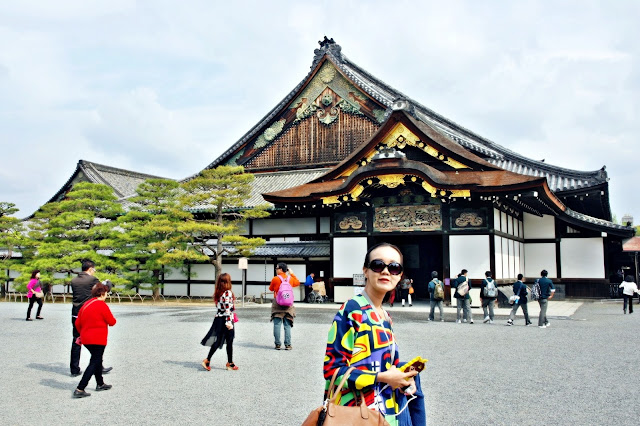Kyoto is a charming city with multihued local customs and rich in traditions. Flourished as the capital of Japan for as long as 1000 years after 794. Kyoto nestled 13 temples, 3 shrines and the Nijo Castle.
Excited to see the itinerary as we'll visiting World Heritage sites in Kyoto: Nijō Castle (二条城), Rokuon-ji / Temple of the Golden Pavilion (鹿苑寺/金閣寺), Kiyomizu-dera (清水寺).

Nijo Castle was our first stop, as it's near to Hotel Granvia Kyoto.
About 15 minutes coach ride from Kyoto Station.

Are you sure this photo was taken around 9:00 am?

Ninomaru Higashi-otemon (higashi = east and mon = gate)
has sturdy and strong gate to defend against enemy attack!

Let's learn more about Japanese culture and
history of epic Shoguns and Samurais...

Introduction of Nijo Castle - UNESCO World Heritage Site since 1994
in Japanese, English, Chinese and Korean languages.
No worry... just listen to our experience tour guide.
Do you think he look like Japanese more than Taiwanese?
Especially when he speaks Japanese... wow!!!
The castle was originally built in 1603 as the official residence
of Tokugawa Ieyasu, the first Shogun of Edo Period.
Tokugawa used Edo as the capital city, but Kyoto continued to be the home of the Imperial Court. Kyoto Imperial Palace is located north-east of Nijo Castle.
Beautiful Ninomaru-goten Karamon has decorative Chinese-style roof ceiling.

Showtime of Shogun and Samurais begin from this Karamon gate!

I heard footsteps on the rooftop! Flying Ninja?! OMG~!

Kurumayose entrance way decorated with ranma-chokoku (a carved transom and
a decorative frieze consisting of carved panels fixed above the head of a door).
On
the front is depicted are five luan (a mythical Chinese bird), pine
trees, peonies and at the top clouds, and at the bottom you can see
grass. On the roof is cypress bark and the base is made of squared
masonry.
Inner Map of Nijo Castle.
Nijo Castle is one of the epitome of early Edo period and Momoyama
culture in Japan with splendid building designs, lavish paintings and
carvings that generously commissioned.
First of all, you need to take off your shoes before entering 3300 square meter Ninomaru Palace. It consists of 5 connected
separate buildings with made of Hinoki cypress wooden floor. The palace rooms are tatami mat covered
Do note that no photography is allowed inside too. It's to protect the original colors of replica paintings on wall paintings.
Nightingale floors (Uguisubari) welcoming us with the squeaking sound like birds chirping when we stepped on it. The squeaking sound is not produced by the floorboard, but by the offset metal hinges triggered when it's under pressure.
Too many people inside, so no matter how soft I walked or slided, the floor bed still squeaked~~~! I need to learn from Ninja how to traverse a nightingale floor without making sound.
According to my guide Ninjas aware of this deadly alarm, because once it squeaked, the occupants will send Samurais out. Therefore, as what we normally watch in movie scenes... they have to 'fly' on the roof to avoid this nightingale board. This is the only way to attack occupants without knowing their presence.
Too many people inside, so no matter how soft I walked or slided, the floor bed still squeaked~~~! I need to learn from Ninja how to traverse a nightingale floor without making sound.
According to my guide Ninjas aware of this deadly alarm, because once it squeaked, the occupants will send Samurais out. Therefore, as what we normally watch in movie scenes... they have to 'fly' on the roof to avoid this nightingale board. This is the only way to attack occupants without knowing their presence.
Entering the building, you can see few chambers, offices and
the living quarters of the shoguns. Some of the rooms have mannequins of Shogun and and his subordinates, officers and attendants.
Our tour guide explained to us, but somehow my Chinese language skill only for basic conversation. It's kinda hard for me to understand. Scratched my head with all these new and unfamiliar words!
To make it worse, there's a tour guide using loudspeaker to explained in strange and unfamiliar foreign language. What?!! Ok... Alright, you won! I'd to off my ears and on my eyes to admire those impressive classical wall and screen paintings.
To make it worse, there's a tour guide using loudspeaker to explained in strange and unfamiliar foreign language. What?!! Ok... Alright, you won! I'd to off my ears and on my eyes to admire those impressive classical wall and screen paintings.
These are some of the paintings found inside
the castle, and you can buy for souvenirs.

Icecream from teahouse / souvenir shop to cold my head
before proceeding to next destination... Golden Pavilion.

Icecream from teahouse / souvenir shop to cold my head
before proceeding to next destination... Golden Pavilion.
Bansho (Guard House) at the back,
previously 50 Samurais were stationed there at a time.
The entire castle grounds and the Honmaru are surrounded by
huge stone walls and deep moats.
Nijo Castle truly demonstrates the power that the Shoguns wielded over the emperors in Japan throughout Edo period.
Add: 541 Nijojo-cho, Nijo-dori, Horikawa Nishi iru, Nakagyo-ku
Hours and Fees Hours 8:45 to 17:00 (admission until 16:00)
Entry to Ninomaru from 9:00 to 16:00













